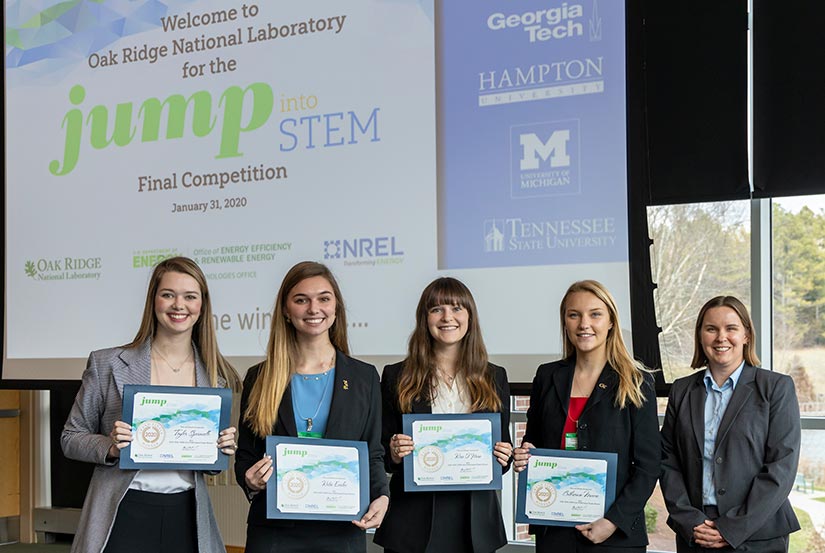Announcing the 2021–2022 JUMP Into STEM Challenge Winners
The Nationwide Building Science Student Competition Awards Teams Addressing Energy and Environmental Justice in a Competitive Field

The next generation of building scientists is responding to the challenges of climate change with solutions that make equity a priority. This year’s JUMP into STEM Challenges asked student teams from across the country to develop inclusive and holistic building solutions, focusing on equal access to healthy indoor air quality, resilience for all, and accelerated market adoption.
"In finding solutions to reducing carbon emissions from U.S. buildings, we need to make sure disadvantaged communities are not burdened by a transition to renewable energy technologies," said Kim Trenbath, National Renewable Energy Laboratory (NREL) innovation lead for systems technology research and development in the Building Technologies and Sciences Center. "We are truly impressed by the quantity and quality of innovative submissions this year. These young professionals continue to inspire us as we move closer to an equitable future of buildings."
2021–2022 JUMP Into STEM Challenge Winners and Runners-Up
Equal Access to Healthy Indoor Air
Winner
Easiair
Tais Mitchell and Jason Talford — University of Idaho
The Easiair system is designed to cost-effectively reduce levels of CO2, radon, and other common contaminants simultaneously by increasing the internal pressure of the building and reversing infiltration through the building envelope.
Runner-Up
IAQ Accessibility Improvers
Nishka Chawla and Julia Rios — California Polytechnic State University, San Luis Obispo
To address the challenge of poor indoor air quality that homeless shelters face and help improve overall short- and long-term health, this holistic solution creates partnerships between shelters and portable air filter companies.
Resilience for All in the Wake of Disaster
Winner
Advancing Resilient Communities in Remote Areas: A Self-Sustaining and Replicable Solution Based in Dennehotso
Samantha Eddy, Xiang Huo, Xinyan Liu, and Xinyang Rui — The University of Utah
Dennehotso, a Navajo chapter, is a sparsely populated area used as a pilot site to illustrate design solutions focused on improving quality of life by providing reliable electricity and internet connectivity, improved air quality and indoor comfort, and uninterrupted food supply, especially during natural and man-made disasters.
Runner-Up
Team Hephaestus
Francisco Diaz-Rodriguez, Jillian Flynn, Alex Holzke, and Ethan Rand — Vanderbilt University
This solution aims to help detect wildfires, especially in rural communities that do not have access to the vast networks and resources available in urban areas. The device is made to be self-sustaining through a triboelectric generator that powers the sensors and can detect a fire within a 400 square meter area.
Solving Market Adoption for Emerging Efficiency Technologies
Winner
Solar City
Carson Bryan, Tyler Elsom, Sachin Gokhale, and Matthew Hyland — California Polytechnic State University, San Luis Obispo
Solar City is focused on strategic outreach to implement modified solar streetlights across the city of Los Angeles to positively impact the community economically and improve the overall quality of life.
Runner-Up
Ensuring That Pacific Northwest Residents Get Efficient Air Conditioners
David Mason, Carson Rinkenberger, and Eli Silva — California Polytechnic State University, San Luis Obispo
This market adoption plan incorporates a combination of discounted energy rates, stakeholder communication, and government subsidies to encourage Pacific Northwest residents to invest in an energy-efficient air conditioning unit to ultimately reduce their electricity usage and long-term electricity costs from extended use of air conditioners during hot months.
Honorable Mentions
The number of high-quality submissions in the resilience category made for an especially competitive field, and the JUMP into STEM administration team would like to recognize the following additional honorable mentions in this category:
- Backup Power in the Wake of Disaster To Increase Hazard Resilience in Low Income Communities
Natasha Ghezawi, Alexandra Kahl, and Kyra Owensby — University of Tennessee, Knoxville
- Solar Schools
Michelle Chen, Liken Hanato, Michael Le, and Alexis Ng — University of Kansas
- Implementation of Affordable Wildfire Prevention Plans
Caleb Erlenborn, Anil Singh, and Ethan Stroh — California Polytechnic State University, San Luis Obispo
JUMP Into STEM Final Event
JUMP into STEM Finalists will be invited to present their solutions during the 2021–2022 Final Event in January 2022 and compete for a paid summer 2022 internship at NREL, Oak Ridge National Laboratory, or the Pacific Northwest National Laboratory.
JUMP into STEM works closely with industry sponsors, including Clayton Homes and DRC Construction, to make this competition a success. Sponsorship funds are crucial to allow for the inclusion of more student teams in the final event, as well as expansion of the reception, activities, and other benefits for final event attendees and challenge winners.
Hy Stor Energy, a startup company working to advance the production, storage, and delivery of green hydrogen at scale, is a new program sponsor this year.
"Hy Stor Energy is proud to support and inspire the next generation of STEM engineers, scientists, and out-of-the-box thinkers," said Claire Behar, Hy Stor Energy chief commercial officer. "Our company is committed to creating resilient communities that have equitable workforce development opportunities in clean energy. We also aim to elevate diverse voices to help us reach our bold and inclusive renewable energy goals."
JUMP into STEM is supported by the U.S. Department of Energy. Visit the Building Technologies Office website for more on energy-efficient building initiatives.
